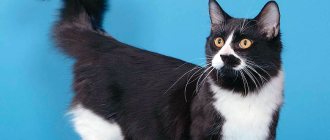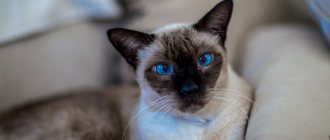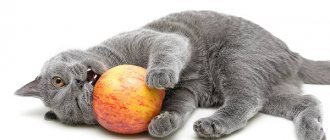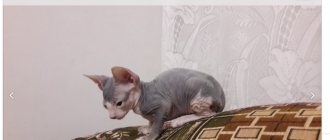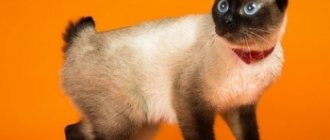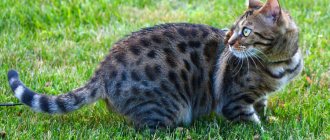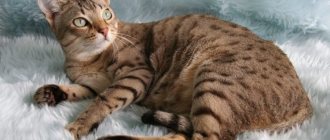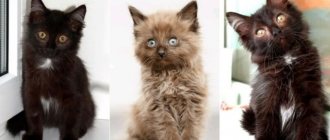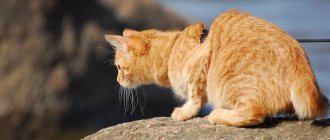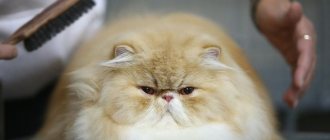History of the Burmese cat breed
Burmese cat
The state of Burma (modern Myanmar) has been famous since ancient times for its delightful landscapes and charm unique only to the countries of Southeast Asia. The virgin nature of the jungle contrasted with the snow-capped mountain peaks, and the white sand of the beaches contrasted with the stone buildings of ancient cities. It was on these mysterious lands that the ancestors of the Burmese breed, one of the most memorable in the world, appeared.
The first mentions of these animals date back to the 12th century. Later, cats were awarded separate lines in the ancient book of poetry, which was replenished with new works during the 14th-18th centuries. No less clear evidence of the ancient origin of the Burmese is provided by the images in the book of Siamese artists, in which, among all representatives of the cat family, an animal with the physique and appearance of our oriental beauty stands out clearly.
The Burmese breed was highly revered by the inhabitants of the ancient state. These cats were allowed into temples because they were considered higher creatures. The monks looked after them in every possible way, thereby demonstrating their commitment to religion and serving the gods. In those days, it was believed that the Burmese cat escorted the soul of its deceased owner to the afterlife, giving him eternal peace as a farewell. According to another legend, the Burmese brought good luck and wealth, so only aristocratic and royal families acquired these cats. Commoners had to be content with more “modest” breeds.
At the end of the 19th century, Burmese cats first set foot on the lands of Great Britain, where the animals were initially known as black Siamese. Over time, the breed spread to all continents of the world. An interesting fact is that the ancestor of the breed in the form in which we know it was not a purebred specimen at all, but a mixed breed of Burmese and Siamese. In the first half of the 20th century, retired American Navy doctor Joseph Thompson acquired a charming kitten named Wong Mau. The baby has grown into a graceful and royally majestic cat of a reddish-brown color with dark tan. Admired by the personality and appearance of his favorite, Thompson began to search for like-minded people who would contribute to the development of a new breed and the creation of its standard. They were scientists from the University of California and enthusiasts from the local felinologists club.
Chocolate Burmese cat
Based on Wong Mau's resemblance to a Siamese cat, Joseph Thompson chose the ideal partner for her breeding - a Siamese named Tai Mau. The first litter produced babies of several colors: seal point and dark walnut. This meant that Thompson’s favorite was a mix of Siamese and Burmese breeds: otherwise the marks would not have appeared. However, the decisive criterion when selecting kittens for further breeding was the chestnut color.
Crossing the offspring of Wong Mau and Tai Mau “gave” three colors: chocolate with dark tan, brown and sable. Of these, Joseph Thompson liked the last one the most. According to the retired doctor, it was this color that looked the most noble and deserved further development.
Burmese kitten
The colossal experience of felinologists played a role: in 1934 the world saw the first standard of the Burmese breed. At the same time, three generations of its representatives were registered. Two years later, the American organization CFA registered the Burmese standard. Considering that work on creating a new breed began only in 1930, such early success could be considered triumphant.
Burmese cats enjoyed universal love and recognition, but the number of individuals remained very limited. To make the breed more widespread, it was decided to cross the Burmese with Siamese and other cats whose color was a bit like Wong Mau. This resulted in a huge number of Mestizos, and in 1947 the CFA stopped registering them. Since then, the pedigree of each kitten was carefully checked: so, it had to include at least three purebred generations.
The ranks of Burmese breeders have thinned significantly, and employees of American nurseries have entered the arena. Thanks to their efforts and organized work to revive the breed, registration of Burmese cats was resumed in 1957: the number of purebred individuals increased several times. A year later, the UBCF organization began to develop a generally recognized breed standard. The result was achieved in 1959 and has not been changed since then. As for color, the first CFA registered was brown, later nicknamed sable due to its resemblance to the fur of this animal. Long-term crossbreeding resulted in the appearance of other coat colors: platinum, blue, golden (champagne).
Burmese cats did not limit themselves to conquering the United States and continued to walk around the world with soft paw pads. In 1949, three representatives of this breed appeared on the lands of Great Britain and aroused universal love and recognition. Throughout the second half of the 20th century, clubs and societies of Burmese cat lovers were created every now and then in Foggy Albion. To increase their numbers, breeders crossed animals with the Siamese breed, which by that time had acquired features familiar to us. For this reason, noticeable differences appeared in the appearance of English and American Burmese. This is how the second breed standard arose - the European one. It is not recognized by the CFA, just like the American one - by the GCCF organization. Crossbreeding of cats belonging to different standards is prohibited.
Having earned the love of America and England, the Burmese breed set foot on the lands of Australia, where it managed to displace the former favorites - the British and Abyssinians - and gain dizzying popularity. The first Burmese appeared in Russia only at the end of the 20th century, but every year they win the hearts of cat lovers more and more.
Origin story
But some experts are confident that the Burmese cat originated in 1934 in America. Dr. Joseph Thompson, from a trip to Asia, brought a cat named Wong Mau to San Francisco. She had an unusual reddish-brown color and soft fur. When she was crossed with a Siamese cat, the cutest kittens were born with the distinctive breed characteristics of modern representatives of the Burmese breed.
Currently, the breed is classified by several standards:
- according to FIFe – III category – shorthair & Somali – BUR standard;
- according to WCF – III category – Shorthair – IGK standard;
- according to CFA – category SH – Shorthair – Burmese standard.
According to classifications, Burmese cats have distinctive breed features and generally accepted characteristics.
Appearance of a Burmese cat
Looking at the embodiment of elegance and grace in this thin cat's body, one cannot imagine that Burmese turn out to be unexpectedly heavy, once you pick them up. For this feature they have earned a humorous nickname - “bricks wrapped in silk.” Males are always heavier than cats: 4.5-5 kg and 2.5-3.5 kg, respectively.
The Burmese cat is a medium-sized short-haired breed. Belonging to one or another standard determines the appearance of the animal: Americans are stockier in comparison with their relatives from Europe.
American Burmese cat
European Burmese cat
Head and skull
The head of the European Burmese is wedge-shaped, while that of the American Burmese is slightly wider. The frontal part of the skull in both representatives of the breed is smoothly rounded. Pronounced flat “areas” in front or profile are invisible.
Muzzle
Both Burmese breed standards are distinguished by a well-developed muzzle that matches the smooth contours of the head. The transition from nose to forehead is pronounced. Cheekbones are clearly visible. A strong chin forms a straight vertical line with the tip of the nose. The American standard Burmese has a wider and shorter muzzle, but the feet are as defined as the European Burmese.
Ears
The triangles of the ears are located far from each other, and their outer side emphasizes the line of the cheeks (uncharacteristic for adult cats). The wide base flows smoothly into softly rounded tips. Due to the slight tilt of the ears forward, the Burmese always looks alert.
Eyes
Burmese cat eye
The Burmese cat's eyes are set wide apart from each other, quite large and expressive. The slight “eastern” slope of their upper line gives the breed a resemblance to Orientals, while the lower line is rounded. Burmese eyes shimmer in all shades of yellow - from honey to amber, with a rich golden tone being more preferable. Pay attention to an interesting feature: the older the animal, the less bright the color of its eyes appears.
Jaws and teeth
If we compare the jaws of a Burmese cat, it can be noted that the lower one is more pronounced and therefore clearly visible when the animal stands in profile. The bite is correct.
Neck
The Burmese breed is characterized by the presence of a long and thin strong neck.
Burmese cat face
Frame
The cat's compact and fit body is the embodiment of grace combined with the hardness of well-developed muscles. The strong chest has a rounded shape. The Burmese's back is straight from the shoulders to the base of the tail.
Tail
It has a medium length and no bends. While not too wide at the base, it tapers to a gently rounded tip.
Limbs
Burmese cat paws
The Burmese cat's limbs are proportional to its body. They are relatively thin, of medium length. They end in graceful oval-shaped paws. The number of toes on the front and hind legs varies: five and four, respectively.
Coat
Representatives of the Burmese breed are characterized by thin and short hair. It fits tightly to the body of the animal and has virtually no undercoat. To the touch – smooth and silky; shimmers beautifully with every graceful movement of the cat.
Color
The upper part of the Burmese body is darker in comparison with the lower part, and this feature does not depend on the color of the animal. An even tone is preferable, but both American and European standards allow discreet points on the face, ears, limbs and tail. Kittens and young individuals can boast of tiger moire.
Recognized Burmese color standards include sable, blue, chocolate, and platinum (lilac). Nowadays there are various tortoiseshell shades based on them, as well as cream and red colors.
Possible defects
Defects of the Burmese breed include:
- tiger stripes on the limbs of adult cats;
- strongly elongated and oblong muzzle;
- round or oriental eye shape;
- sharp narrowing of the muzzle under the cheekbones;
- noticeable hump on the nose;
- sunken cheeks.
The breed standard also mentions disqualifying characteristics:
- malocclusion and developed upper jaw;
- green or blue eye color;
- irregular tail shape;
- white points on coat;
- strabismus;
- deafness.
Character and health
Representatives of this breed are not always miniature. Adult cats reach a weight of 8-9 kg, and male cats - 5-6 kg. It is noteworthy that the beautiful iridescent fur of purebred cats is temperature dependent. So, in the autumn-winter period, when it is cold outside, it is darker. And on hot summer days it becomes lighter. In addition, their hair is absolutely hypoallergenic and safe.
Representatives of the breed have completely human eyes, intelligent and understanding. Thanks to a well-developed muscle system, a cat can make unusual body movements and perform tricks during games. Having relaxed, she becomes tender and soft.
Burmese dogs are devoted to man, to their owner. This feature distinguishes them from other breeds. They are loving, do not show aggression and treat all members of their family well.
They love children very much and will never harm them; they are ready to play all day long, entertaining their little owner.
The cat's habits and sensitivity to the slightest changes in the owner's mood make the cat acutely sense changes and make its own adjustments. They have the abilities of healers and are always ready to help.
Pets are not quick-tempered and calmly accept, for example, dogs living with them in the same house. But at the same time they are able to repel even an enemy with twice the height and weight.
Cats of this breed are very active and playful, have an easy-going character, but are also smart. They are trainable and can even perform simple tricks. In addition, the Burmese can “talk” by making unusual sounds with their mouths closed.
The health of the Burmese cat is quite good, its immunity is strong. The description of the Burmese says that the most common diseases for them are dental problems. To avoid this, you will have to undergo an annual examination with a dentist and carry out preventative cleaning.
Adult cats tolerate pregnancy well, but childbirth is difficult. Therefore, this process takes place under the strict supervision of a veterinarian.
Photo of a Burmese cat
Tips for choosing a kitten
To purchase a Burmese kitten, be sure to contact the nursery!
This will be a kind of guarantee that the animal has a pedigree and the absence of various diseases.
Of course, you can purchase an animal both on the market and through online advertisements; fortunately, nowadays there are plenty of people willing to sell. And such a purchase will most likely help save the family budget. But in this case, you cannot be firmly confident either that the kitten belongs to the right breed, or that it does not have diseases that you will have to fight with for the rest of your life.
If you are finally ready to buy a Burmese kitten, decide on some points.
- Is this just a family friend or a potential participant in future exhibitions?
- Boy or girl?
- Baby's color.
If participation in exhibitions is not planned, then choose your pet according to your heart. It is “your” baby who can bring you a sea of joy and positivity.
There is also not much difference between boys and girls. Both are distinguished by cleanliness and equally love their owner. The only thing is: cats will have more weight, while the appearance of the cat will be more graceful.
The baby's color changes and is fully formed only at a later age!
If you have decided on all the issues, be sure to examine the animal and talk to the breeder. The kitten must have a clean and well-groomed appearance; the first worming and vaccination have usually already been carried out by this time. The breeder will clarify the baby’s nutritional issues and give the necessary recommendations.
Character of the Burmese cat
Among all the cats, you will not find an animal more devoted and cheerful than the Burmese. Don't expect to find a calm and reserved character in this breed. If the cat suddenly freezes, then know: it won’t last long. It is quite possible that in this way your pet is studying the situation and “planning” an entertainment program for the rest of the day. Activity is a constant companion of Burmese cats until old age. You should not hide your pet’s favorite toys in a box, citing her old age. Many elderly Burmese will still give kittens a head start and happily run after a sunbeam or a fly that came from nowhere.
Who are you?
Representatives of this breed have gained fame as cats with a dog's soul. They love to spend time with their owners and participate in every moment of their life, responding to care with boundless tenderness. Between a person and sleeping in an easy chair, the Burmese will choose the first without hesitation. This cat enjoys physical contact with its owner. She will happily follow on your heels and crawl under the covers at night to get her portion of love.
Burmese cats are sensitive to mood and will take any action in an attempt to bring a smile to your tired face. These animals are reputed to be ardent lovers of intimate “conversations” - and not with their relatives, but with humans. Get ready for your pet to speak in cat language, while keeping prying eyes on you. Her gentle purring will brighten up even the most difficult and unpleasant day.
An interesting feature of the Burmese is their different attitude towards the owner depending on gender. Cats tend to love all family members equally, while a cat happily runs into her arms and fawns only on her favorite. This is striking when there are two individuals of different sexes in the house. The cat is destined to become your best friend, who will relentlessly follow on your heels and try to smooth out your problems with the pleasant weight of his body. Cats prefer to adapt to the mood of the owner and never impose themselves if the owner needs solitude.
The Burmese breed gets along well with other pets. These cats will be able to find a common language even with the most gloomy dogs and will certainly not make a parrot their holiday dinner.
Today I will lead
The Burmese are no less kind to children. They will never scratch a baby for a careless poke or an overly tight hug. Moreover: the Burmese cat will take part in the children's game as much as possible. Her graceful and light jumps delight and often attract all family members who want to admire the flexible beauty. Such attention to the modest person of the Burmese acts as a balm for the soul: the animal will jump even higher, bend even more, wanting to hear sincere exclamations of admiration.
Representatives of this breed cannot stand loneliness, as they constantly need a partner to play with. If you spend most of your time outside the home, take care of your pet's state of mind. A second Burmese cat is an ideal option. Rest assured: the animals will not get bored in your absence, and upon your return they will be able to entertain them with active games of “catch-up”.
Obey
Interesting facts about the breed
- A photo of Hollywood actor Nicolas Cage with his favorite Burmese cat has become popular.
- The Burmese cat breed is ideal for single people, it is a loyal companion and has high intelligence.
- For many, the grand Burmese cat evokes pride and vanity.
- According to an ancient Burmese legend, 100 Burmese cats guarded the sculpture of the golden goddess in the Lao Tsung Temple. When the robbers attacked the temple and killed the abbot, the white cat Singh touched his hand and turned into a golden animal with blue eyes like those of a goddess.
Education and training
Among all breeds, Burmese are distinguished by their high level of intelligence, which is confirmed by many owners of these cats. They can easily open a door that is not tightly closed or reach the switch with their paw to extinguish the large “sun” under the ceiling. With sincere desire and patience, you can easily teach your pet simple dog commands: “Sit!”, “Lie down!” and bring an abandoned toy.
Burmese cats easily get used to the litter box and regularly use it as a toilet, so unexpected “bombs” in slippers and shoes will not lie in wait for you.
Pet character
It’s not for nothing that this breed is called a cat-dog. She is very attached to her owner, loves to be near him and cuddle. It seems that the whole meaning of life for her is to be as close as possible to the object of her love. The animal does not like to be left alone. It will be very bored and may even become depressed.
If you have to leave your cat at home all day, make sure she has a social companion.
For a cat of this breed, it is important to constantly be the center of attention. She can rush around the apartment, jump on shelves and cabinets, run across the sofa, throwing pillows to the sides, and at the same time constantly glance sideways at the owner to see whether her actions have attracted the proper attention.
Believe me, if you decide to be cool about all these animal antics and simply ignore them, the cat will come up with something more original that will definitely attract attention to its maneuvers. The Burmese retain this craving for games and “demonstration performances” until old age. Its actions are dictated by the desire to frolic, and the animal almost never causes material damage to the house in which it lives.
A special feature of Burmese cats is their ability to get along well with children. A cat will never hurt a child. In this situation, it is important to note that these pets very rarely release their claws, so you don’t have to worry that the Burmese will injure the baby in the moment of self-defense.
Well, the Burmese will have good relationships with other pets, dogs and cats, only if they unconditionally recognize its superiority over them.
Cats of this breed meow only when they want to convey something to their owner. Moreover, they have a very good command of intonation.
The Burma very subtly senses the mood of its owner and reacts correctly to it. She understands when it is better not to touch the owner or, conversely, when he needs increased attention to lift his spirits.
Cats of this breed have a high level of intelligence. If desired, they can be easily trained.
The Burmese cat is very responsive to human affection. This quality makes the animal a very grateful pet.
Despite the excessive activity and love of games, the pet will happily doze off on the owner’s lap or lie calmly under a hand stroking it.
A cat very often prefers to sleep with its owner in his bed.
The Burmese cat is completely unsuitable for street keeping, since it is not at all afraid of transport, and curiosity often leads it to unfamiliar cats or dogs, which can be carriers of diseases or show excessive aggression. Transport also very often poses a threat to the life and health of the animal.
When walking your pet outside, be sure to use a leash. For the Burmese, true pleasure is to escape from the owner and go to explore the world.
Burmese cats are brave, energetic, lively, inquisitive, completely non-aggressive, capable of surprising a person throughout their life.
Care and maintenance
Representatives of the Burmese breed are completely unpretentious in care. Short hair only needs brushing once a week (during shedding, it is recommended to do this more frequently). In this case, you can use a special antistatic agent. There is no need to regularly give your beauty a “bath day”: Burmese are very clean by nature and therefore monitor the condition of their fur on their own. All you have to do is wipe your cat daily with a barely damp cloth or piece of chamois to remove dead hair and add a glossy shine to the animal's silky coat.
Burmese sable cat
However, if your cat gets dirty somewhere, or you are planning to take first prize at an exhibition, wash your pet with a mild shampoo for short-haired breeds. Do not forget to regularly shorten the nails using a special pruner if the scratching post does not attract your beauty at all.
Particular attention should be paid to feeding the Burmese cat, otherwise you will become a frequent visitor to veterinary clinics. It's worth shelling out for premium dry food. They contain a complex of vitamins and minerals that will allow the Burmese to maintain its noble appearance, and its coat to shimmer beautifully in the light.
It is not recommended to feed the animal the same thing. Burmese cats can be very picky, and it is possible that after a month they will not even approach a bowl filled with their previously beloved food. It is recommended to dilute the animal’s diet with solid food: this will prevent the formation of tartar.
Burmese kitten
Please note an important feeding feature. As long as there is a mischievous kitten running around your apartment, you should not limit its food intake. However, this cannot be said about an adult animal, which easily gains weight and soon turns into a clumsy bun on its feet. Make sure that your heart does not melt at the pitiful, pleading look of the Burmese, and the cat will retain its natural elegance for a long time.
After a fun feast, is there a lot of food left? Don’t rush to share it with an animal: not all “human” foods are easily digestible. Should be excluded:
- pickled, spicy and fried foods;
- vegetables – tomatoes, garlic, onions;
- from fruits - raisins and grapes;
- pork in any form;
- boiled potatoes;
- tubular bones;
- legumes;
- mushrooms.
Drinking water must be filtered. If you want to pamper your Burmese, buy premium bottled water. But you shouldn’t boil it: this can lead to the development of urolithiasis in your pet.
Sweet Dreams
Care
Burmese breeds are not particularly demanding in terms of care; it is enough to satisfy some basic needs of the animal.
Wool
The coat of a Burmese cat is special and requires attention and care. The wool is soft, comparable to mink, and has no undercoat . They are also called “silk bricks” because of their exquisite coating and considerable weight. To preserve the beauty given by nature, you need to comb the animal at least once a week with a special glove or brush. On its own, the Burmese Shorthair practically does not shed , which allows it to be kept even by allergy sufferers (only if the allergy is not to cat saliva and skin particles).
You should bathe your pet no more than once every 5 months. The only exception would be severe pollution or going to an exhibition. If the owner does not have the opportunity to care for the cat on his own, then you can contact veterinary offices that provide grooming services - caring for the appearance of pets.
Nutrition
The nutrition of Burmese cats does not differ from generally accepted standards of care, since they are not prone to allergic reactions and digestive problems. There are two options for feeding Burmese cats: homemade and store-bought food. With the right approach, both methods will be acceptable. To better understand, you need to consider each method separately.
Homemade food , of course, will have a positive effect on the pet’s well-being, but a considerable amount of time is devoted to this method. of raw defrosted meat per day , which is about 80% of the diet . The meat should be lean, preferably lamb, rabbit, beef, and poultry. To make it convenient for the cat to eat, you need to cut it into small pieces of 1x1 cm.
Vegetables and herbs are served with meat , but some Burmese cats refuse such an addition and independently look for healthy herbs in the clearing or garden. Dairy products also make up a large share of the diet: cottage cheese, yogurt, fermented baked milk . a hard-boiled egg twice a week fish meat once . The bones must be removed first.
Dry food or canned food can now be found in any veterinary store. But his choice should be approached responsibly. The main proportion of the feed composition should be animal proteins . To a lesser extent, proteins of plant origin, fiber, vitamins, and microelements are present. Good food does not require additional investment in nutritional supplements. We have prepared a rating of the best wet food, which you can see in our article.
Important! Under no circumstances should you feed your pet both store-bought food and homemade food at the same time. They are poisoned differently, so together they disrupt the digestive process.
Caring for ears, eyes and other body parts
Because Burmese cats are prone to colds and watery eyes, you need to pay attention to caring for their eyes. As with other breeds, proper weekly cleaning of the eyes and ears with a cotton swab dipped in a special solution is important. If you notice moisture near the nose and eyes, it is important to promptly wipe them with veterinary products. If the discharge does not stop, the animal must be taken to the veterinarian immediately.
These cats rarely produce claws, so there is no particular need to cut them off often. Burmese cats treat furniture with the same respect - they do not like to tear or tear it off. We can conclude that for aesthetic purposes it will be enough to cut off the claws once every 1-2 months .
Important! Cats need to have their claws trimmed correctly! In no case should this be done at the root, but only by removing the sharp ends. In addition, cutting the claw lengthwise, like a human, will cause suffering to the poor animal. You need to cut across the wide side.
Walking your pet
Since Burmese cats have a calm disposition, they are kept both in a private house and in an apartment. But in any case, free range is not the best solution. It would be ideal to accompany your pet on a walk. Because of its curiosity, the Burmese cat will try to get acquainted with all the nooks and crannies, so it would be a good idea to purchase a special leash.
Health and diseases of the Burmese cat
Among all breeds, it is the Burmese that has strong immunity. These cats are not susceptible to hereditary diseases, which makes them excellent specimens for selection. But pathologies from which the Burmese suffer are still observed. Among them:
- labored breathing;
- severe lacrimation;
- skull deformation;
- inflammation of the gums;
- tail defects.
To maintain your pet's health, it is recommended to visit a veterinarian regularly and get vaccinated. Anthelmintic drugs should be firmly established in the animal “first aid kit”. Even if your cat does not go for walks, it is necessary to give the medicine every six months. If you are regularly away from home – once every three months.
Keeping Burmese at home
Interesting to know! It is believed, according to ancient beliefs, that Burmese cats bring good luck to the house. That is why they were kept in temples, as well as in the abodes of rich people, who believed that these cats contributed to the appearance of wealth, prosperity and family happiness in their home.
In fact, such legends have nothing to do with the behavior of this cat, since they themselves represent an ideal animal for keeping at home. These are friendly and fairly clean pets. At the same time, they have a hard time experiencing long-term separation, remaining alone, and this factor must be taken into account.
Due to the fact that Burmese cats are quite curious by nature, it is necessary to ensure that they do not have access to various things and household items, especially at a young age. The same applies to household chemicals that cats can taste.
It is not recommended to let this cat go for a walk on its own. It is very important that she is on a leash. You can let her out at your dacha, but it is better to always remember that the cat is vaccinated and also take care of other means of protection, such as a flea collar, for example.
Care and hygiene
These cats do not require special care, especially since they have short hair without undercoat. The coat is combed once every 2 weeks and this is quite enough. You should also not bathe your animal frequently. It is enough to organize water procedures a couple of times a year.
As a rule, they tolerate water procedures without problems, since they completely trust their owner. The eyes and ears of your pet should be cleaned once a month, and the nails should be shortened once every 2 months.
What to feed
When feeding ready-made dry factory mixtures, preference should be given to premium or super-premium food. This is necessary to ensure that the cat receives all the necessary nutritional components, which is so important for the health of a domestic cat. When feeding kittens, care must be taken to include low-fat boiled fish in their diet. To effectively fight tartar, you need to make sure that dry food is present in your diet.
It is better to give older cats natural food, including rabbit meat, chicken or beef, but in the form of minced meat, since old animals have great difficulty chewing solid food. Pregnant or lactating cats require increased nutrition. To do this, it is enough to increase the daily ration or use special purchased feed. Nowadays, you can buy any food for animals in specialized stores.
Important to remember! Your pet should not be allowed to overeat. These are large animals with a good appetite that can eat more food than they should. In this regard, it should be noted that this breed is prone to gaining excess weight, and this can lead to health problems.
Under no circumstances should cats be given food from the human table. People tend to eat salty, spicy or sweet foods, which are harmful to pets, including cats, regardless of breed.
5 features of keeping a Burmese
Diseases, breed defects
These cats are susceptible to extremely unpleasant diseases, and this is true both in relation to the European Burmese cat and in relation to the American one. This is one of the negative factors that scares away many who want to have a Burmese cat at home. Therefore, when choosing a kitten, it is very important not to make a mistake.
Gangliosidosis is considered one of the most common hereditary diseases of the nervous system. The disease begins to manifest itself from an early age in the form of lameness and paralysis. As a rule, the pet dies because this disease cannot be treated, despite the enormous efforts of modern scientists who are trying to solve this problem.
Hypokalemia, which is associated with a lack of potassium in the animal’s body. A deficiency of this component leads to increased fatigue, as well as general lethargy. The disease can be treated by administering drugs containing potassium ions. Otherwise, the process worsens and paralysis of the animal occurs.
Burmese cats may develop flat chest syndrome, which can be detected in the first days of a kitten's life. This disease is associated with imbalance of the chest muscles, which leads to disability of the animal. There is no effective treatment for this disease, although some kittens manage to survive this disease, after which everything returns to normal.
The eyes, ears and mouth are also considered areas that are prone to various abnormalities. In any case, you should seek help from a veterinarian, since only specialists can prescribe the correct treatment.
Important point! Veterinarians have all the necessary information, as well as medications that will help solve various health problems for pets.
How to choose a kitten
Burmese kittens are separated from their mother at the age of 3-4 months, when the physical and psychological health of the babies is no longer at risk. Be prepared for the fact that, due to the characteristics of the breed, kittens may look significantly smaller than their relatives, but this is by no means a defect. Don't be confused by clear discharge from the eyes: this liquid serves to cleanse them. However, the yellow or white color of the “tears” should be an alarm bell and a reason to visit the veterinarian.
The color of Burmese kittens takes up to a year to develop, so the sable coat initially has shades of beige. If you are planning to get a pet to participate in exhibitions, pay attention to an adult animal.
It is best to purchase purebred Burmese from specialized nurseries: this way, the chances of getting a cat full of energy and health in the future increase significantly. The bird market is the last place you should go in search of your future friend.
Features of feeding and diet
Pet food is divided into natural and dry. Meals with regular foods should include:
- meat (beef, rabbit, turkey, chicken) and offal (stomachs, hearts);
- fermented milk products (cottage cheese, yogurt, kefir), necessary for the normal growth and functioning of bone tissue;
- boiled or pureed vegetables and herbs.
Contrary to popular belief, cats are not suitable for feeding on milk and cereals. Milk is only good for newborn kittens and causes stomach upset in adult animals. Instead of cereals, the diet should contain bran, which normalizes intestinal motility. A couple of times a week, your pet can be fed chicken or quail eggs. Additionally, you must purchase vitamins and minerals prescribed by your doctor.
Feeding guidelines for an adult animal over 1 year of age suggest 2 meals per day. For teenage kittens over 4 months old, the frequency of meals is 3 times a day. The maximum frequency is typical for kittens younger than 4 months, for pregnant and lactating cats. Such animals are fed 4 to 6 times a day.
When choosing dry food, give preference to high-quality super-premium or holistic-class food. The advantage of industrial feed is that it saves time on cooking and trying to calculate the daily calorie content and the BJU norm. All norms are calculated in advance and indicated on the packaging. The daily portion includes all the vitamins necessary for the normal development of the kitten.
Be sure to ask your veterinarian what food to feed your sick pet. Any disease imposes its own restrictions, so adjustments in your usual diet are required.
Photos of Burmese kittens
Purchasing a Burmese kitten
When deciding to purchase a Burmese cat kitten, you need to understand that this must be a conscious and balanced choice. It is not recommended to purchase a Burmese kitten from someone else. If a potential owner wants to get a purebred kitten, then it must be purchased exclusively from a nursery. Only in this case can you purchase a healthy purebred kitten that can meet all the owner’s expectations.
Criterias of choice
When choosing a kitten, do not hesitate to ask the breeder about the character, nuances of keeping and the peculiarities of caring for the cat. You should also tell the seller about your expectations and goals. Usually, owners of trusted catteries are happy to select a kitten in accordance with the wishes of the potential owner.
- The baby should be active, playful and mobile.
- The kitten's fur is silky and shiny. Spots and medallions, as well as numerous white hairs in the color, are unacceptable. There may be faint stripes that disappear after six months. Over time, the baby's fur will acquire a darker shade.
- Ears, eyes, nose are clean.
At what age should you buy a kitten?
It is best to purchase kittens older than three months, since at this age the baby can be weaned from its mother and has already received the necessary vaccinations.
Other purchase details
There is no need to pick up a kitten directly from the exhibition; it is better to visit the nursery and see the conditions in which the kittens are kept and the behavior of the babies in their familiar environment.
If you purchase a baby for subsequent participation in exhibitions, the breeder will select a show-class kitten, but if you just need an affectionate and loyal friend, then when choosing, you can be guided solely by personal sympathies.
Burmese kittens are very inquisitive
How much does a Burmese cat cost?
The price of a Burmese varies from 15 to 35 thousand rubles, depending on the place where the animal was purchased and its pedigree.
Abroad, these figures increase significantly: from 32 to 40 thousand rubles. The price may be lower in pet stores, but don't be fooled by that. However, if you need a loyal friend, and not a future exhibition winner, you can take a baby without an outstanding pedigree. Fortunately, many nurseries provide a choice between elite kittens and those with disqualifying characteristics. The latter are often sold with the condition of mandatory castration, since such animals are not suitable for breeding and development of the Burmese breed.
Buy a Burmese kitten
global $ads_google;
//data-ad-slot=”2475549904″ $ads_google = empty($ads_google) ? false : true; ?> if ($ads_google == false) {?> $ads_google = true; ?> } ?> Since the Burmese breed is quite widespread in the world, buying a kitten will not be so problematic. The main selection criterion is to purchase a cat in a nursery, and not a cat in a poke on Avito. Kittens from nurseries at 3 months are already litter box trained, have completed vaccination and quarantine courses, switched to cat food and are completely healthy.
The average price for Burmese kittens in Russia is 20,000 rubles.
Conclusions about the breed
The Burmese cat is an amazing animal from Southeast Asia. Among her undoubted advantages are not only her pretty appearance and innate grace, but also her friendly character. Thanks to him, the pet finds a common language with all the inhabitants of the house. The Burmese is unusually playful and active. It seems that she only stops when she is planning her next entertainment.
The main thing a cat needs is the attention and love of its owner. But he, in turn, must repay the affection, caresses and unobtrusive purring by creating all the conditions for the healthy development of his pet. Not only proper nutrition is important, but also regular coat care, which does not take much time.
Feeding the cat
Burmese are not prone to allergies and do not suffer from lack of appetite. Therefore, they can be given both industrial and natural food.
When purchasing dry food for a Burmese cat, you should choose premium or super-premium products that contain all the necessary substances:
- Hills;
- Pronature;
- Bosch;
- Gemon;
- Brit Care.
With a natural type of feeding, the cat's diet is composed so that it contains 70-80% meat. The Burmese are also given:
- boiled vegetables;
- porridge with water;
- boiled eggs;
- offal;
- dairy products;
- lean sea fish.
Sausages, smoked meats, pork, bones, sweets and potatoes are forever excluded from the Burmese cat's menu. Also, representatives of the breed are not given pickles, fresh milk, pastries, river fish or any food from the master's table.
On a note. The Burmese, who eat natural foods, are given vitamin and mineral supplements twice a year. They are selected taking into account the cat’s health condition, after consulting with a veterinarian.
Breeding the Burmese breed
Breeding Burmese cats requires certain knowledge.
Criteria for choosing a partner
When choosing a partner for a Burmese cat, it is necessary to carefully study the pedigrees of both animals in order to avoid the manifestation of genetic defects in the offspring. American and European Burmese cannot be crossed with each other.
- When choosing a partner for mating, you should choose a healthy and beautiful representative of the breed. One of the animals must already be untied, otherwise the planned mating may not work out.
- The partner must not have any congenital defects or diseases.
- Both animals must be vaccinated and dewormed 14 days before the intended mating.
- Cats and cats should have their claws trimmed to avoid injury during mating.
In addition, you should remember that the cat should not be washed before mating so that its smell does not disappear. Mating is carried out only on the territory of the cat. The cat is brought to him after the start of heat and left for several days.
Choosing a mate for a Burmese cat is not easy.
At what age should you give your pet for the first mating?
The Burmese cat is characterized by early puberty, the first signs of which can be noticed already at six months of age. At the same time, Burmese estruses are frequent and are accompanied by loud “singing.” The first mating of Burmese cats is allowed after the first or second heat, but not earlier than she is one year old.
How often can a cat give birth?
Burmese, like other felines, can give birth several times a year. However, frequent childbirth is harmful to the health of the animal, since the body does not have time to recover. Therefore, a cat taking part in breeding can give birth 3 times within two years.
Burmese cat is a very caring mother
If the mating is successful and pregnancy occurs, the Burmese will bear kittens for 62–72 days. Typically, a cat of this breed gives birth to 3 to 5 babies. Having become a mother, a Burmese woman shows her best parenting qualities. She is caring and gentle with the kittens, takes care of them touchingly and teaches them good manners, from visiting the litter box to interacting with people. Unlike other breeds of cats, the Burmese allows a person to examine their offspring and take the babies in their arms.
Cons of the breed
The negative characteristics of the Burmese breed may change the decision to take such a beauty into your home. The owners of these cats note that they have virtually no flaws. But still some disadvantages are worth noting:
- Burmese people have a very hard time with loneliness . It is this feature that you need to pay attention to. If the future owner is often away from home, it is not advisable to purchase an animal of this breed.
- Early maturation and frequent estrus in females cause concern for domestic animals.
- These Asians are overly curious . Sometimes this quality poses a threat to their life. Keep an eye on open doors and windows.
- Due to the lack of undercoat, Burmese are cold . Therefore, you will have to provide them with warm places to sleep.
- Developed muscles are a consequence of activity. Representatives of this breed are very jumping . But when jumping from one point, they don’t always hit the target. Therefore, it is better to keep fragile and valuable things out of their reach.
- Burmese are overly trusting . If the owner is planning a trip to an exhibition or a trip to the country, he will have to constantly monitor the cat. She is not afraid of strangers and can easily fall into the hands of an ill-wisher.
- Burmese kittens are called "ugly ducklings" . They look awkward and comical. But after a few months they turn into Asian beauties.
- The Burmese have a short nose . This is the cause of difficulty breathing. The cat often snores and sniffles.
- High price and small number of proven nurseries.
The most significant disadvantage of the Burmese is their attachment to people . If a cat is left alone often and for long periods of time, over time this will affect the health and behavior of the animal.
Breed defects
Burmese are distinguished by good health and have good immunity. However, a tendency to certain diseases is still present.
Common Breed Diseases
Among the most popular diseases for Burmese are the following:
- gingivitis (gum inflammation);
- deformation of the skull (congenital);
- increased lacrimation;
- labored breathing.
Regular visits to the veterinarian, timely vaccination and deworming will help you avoid health problems for your pet. As a preventive measure and to get rid of worms, the cat is given anthelmintic drugs at least once every six months and always two weeks before vaccination.
Once a year, the cat is given an antiviral vaccination and once a year a rabies vaccination. Before vaccination, a doctor's examination is required, since vaccination is carried out on a healthy animal.
Defects in appearance
Breed standards do not allow Burmese cats with the following defects to qualify:
- Broken or abnormal tail, medallions or spots.
- Blue eyes. Strabismus. Incorrect color of nose or paw pads.
- Malocclusion leading to severe overbite or underbite, which visually violates the profile described in the standard.
- Improper jaw formation, resulting in protruding, protruding teeth or a distorted face or jaw.
- Pronounced stripes along the body. Any color that differs from the acceptable ones.
